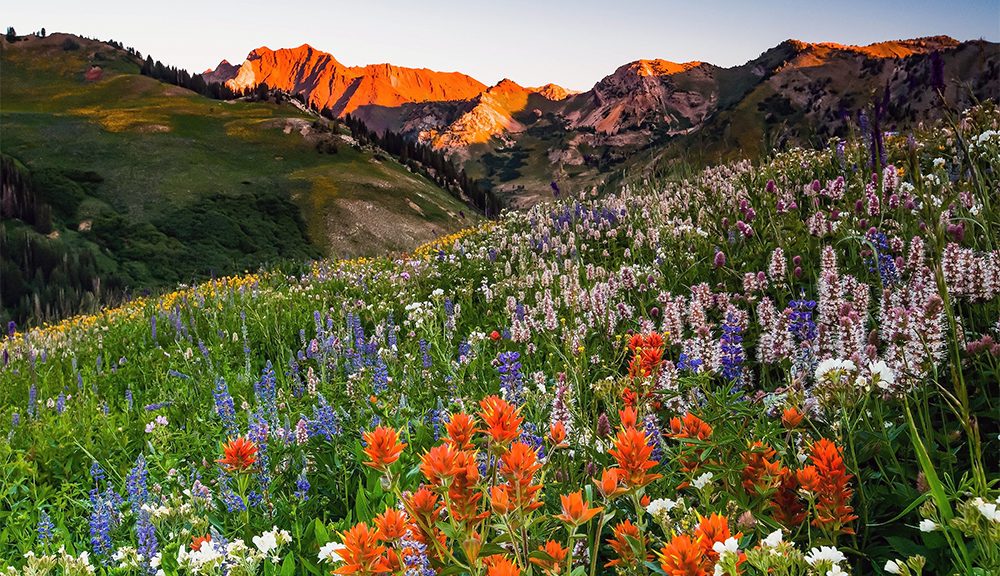
As the scent of fresh wildflowers permeates the crisp mountain air, the Great Smoky Mountains National Park readies to host the 68th Annual Spring Wildflower Pilgrimage (2018), a seasonal event aimed at spreading knowledge of the natural area. From April 24-28, learn everything there is to know about the flora and fauna of the Smokies with over 150 available programs. Featuring professionally guided tours through the national park, the Spring Wildflower Pilgrimage gives people a chance to learn from the best, and what better way to learn about nature than to take a walk in it!
More than Wildflowers
As you know, a pilgrimage is more than just taking a walk — it’s taking a journey to discover something new. Whether you’re an expert or a novice, everyone who seeks not only to enjoy nature but also to gain a greater understanding of it may participate in this event. Pilgrim registration opens on March 1, so mark your calendars to secure your spot. If guiding is more your style, sign up for a leadership role instead; leader registration opens January 15. Get ready to pursue knowledge — nature’s way!
Learn about:
• friendly fungi
• ferns of all sorts
• whimsical wildflowers
• medicinal plants
• trees and shrubs
• terrestrial and aquatic insects
• birds of every kind
• salamanders and snakes
• mammals of all shapes and sizes
Local Flora and Fauna
As the most biologically diverse national park in the United States, it’s no wonder the Great Smoky Mountains National Park is a prime destination for outdoor enthusiasts. With over 1,500 flowering plant species and 100s of animal species, you never know what you may see or encounter on the Spring Wildflowers Pilgrimage. Keep your eyes peeled for foamflowers, lady slipper orchids, bleeding hearts, wild geraniums, little brown jugs, and spring beauties as well as song sparrows, blue jays, hellbenders, river otters, white-tailed deer, and black bears – just to name a few!
What Else?
Along with studying the wondrous wildlife of the Smoky Mountains, other learning opportunities will also be available at various venues throughout Gatlinburg, namely the W.L. Mills Conference Center, for the Spring Wildflower Pilgrimage event. For instance, you could take part in a course on journaling, art and photography, or park history. From indoor seminars and art classes to outdoor motorcades and photographic tours, there will be lots to do and even more to study throughout the surrounding area.
W.L. Mills Conference Center
303 Reagan Drive
Gatlinburg, TN 37738
865.436.7318, ext. 222
Pilgrimage Guidelines
While the Pilgrimage leaders do have the right — permits and all — to directly handle organisms (plants, fungi, invertebrates, reptiles, and amphibians) within the national park boundaries for educational purposes, it is neither allowed nor advisable for park visitors (aka pilgrims) to do so. Please protect the local wildlife, cultural sites, and natural resources by following the National Park Service guidelines below.
“Take nothing but pictures, leave nothing but footprints.”
- Plants prefer to stay put, so please leave them be (petals, leaves, limbs, roots, etc.).
- Proper hand coverings must be used when touching salamanders — after receiving pilgrim leader permission of course!
- While collecting things may be your thing, please leave all natural things (organisms, rocks, and the like) in the national park.
- Avoid feeding animals as they may pursue more — yikes!
- Luring birds with recorded bird calls or songs is prohibited…and confusing.
- Steer clear of the unoccupied buildings in Elkmont to help preserve history.
- When traversing the trails, stay on them; getting lost isn’t as fun as it sounds…in fact, it isn’t fun at all.
- Leave your pets cozy at the cabin when hiking trails that are not pet friendly.
Event Partners
In 2017, over 700 pilgrim participants from the U.S. and several other countries completed their journey on the Spring Wildflower Pilgrimage. With an event of this size, partners are essential, and the Spring Wildflower Pilgrimage has partnered with some incredible organizations.
First on the list is the National Park Service, entrusted with the duty of carefully preserving the Great Smoky Mountains National Park for our and future generations to enjoy.
Next up is the Arrowmont School of Arts and Crafts, dedicated to providing both educational and creative experiences to the local community.
Also partnered is the Great Smoky Mountains Association, devoted to educating the public on and supporting the preservation of the Great Smoky Mountains National Park.
Then, there is the Association of Southeastern Biologists, aimed at promoting, researching, and teaching all things biology since 1937.
Finally, we have the Department of Ecology and Evolutionary Biology from the University of Tennessee (Knoxville), committed to the education of undergraduates and graduates alike in research areas of ecology and biology.
